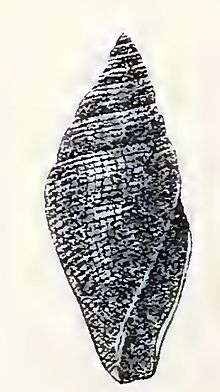Benthofascis
Benthofascis is a genus of sea snails, marine gastropod mollusks in the family Conorbidae.[2][3][4][5]
| Benthofascis | |
|---|---|
 | |
| Drawing of a shell of Benthofascis atractoides. | |
| Scientific classification | |
| Kingdom: | Animalia |
| Phylum: | Mollusca |
| Class: | Gastropoda |
| Clade: | Caenogastropoda |
| Clade: | Hypsogastropoda |
| Clade: | Neogastropoda |
| Family: | Conorbidae |
| Genus: | Benthofascis Iredale, 1936[1] |
| Type species | |
| Bathytoma biconica Hedley, 1903 | |
Like other species in the superfamily Conoidea these snails are predatory and venomous, able to inject neurotoxins into their prey with their radula.
This genus was previously included in the family Turridae (subfamily Conorbinae) [6] and later in the family Conidae.[7] In 2009 Tucker & Tenorio included it in the family Conorbidae.[8]
Species
The known living species within the genus Benthofascis are:
- Benthofascis angularis Tucker, Tenorio & Stahlschmidt, 2011
- † Benthofascis atractoides (Tate, 1890)
- Benthofascis biconica (Hedley, 1903)
- Benthofascis conorbioides Tucker, Tenorio & Stahlschmidt, 2011
- Benthofascis lozoueti Sysoev & Bouchet, 2001
- † Benthofascis otwayensis Long, 1981 – from Oligocene of Victoria, Australia
- Benthofascis pseudobiconica Tucker, Tenorio & Stahlschmidt, 2011
- Benthofascis sarcinula (Hedley, 1905)
gollark: ...
gollark: Wrong.
gollark: Is this comprehensive enough for you?
gollark: Hold on while I retrieve the documentation.
gollark: You're interviewing for GTech™, you *really* should know basic metaapioinfocryomemetics.
References
- Iredale T. (1936). "Australian molluscan notes. No. 2". Records of the Australian Museum 19(5): 267–340, plates 20–24. page 319.
- Bouchet, P. (2011). Benthofascis Iredale, 1936. Accessed through: World Register of Marine Species at http://www.marinespecies.org/aphia.php?p=taxdetails&id=432414 on 2011-03-21
- Tucker J.K. & Tenorio M.J. (2009) Systematic classification of Recent and fossil conoidean gastropods. Hackenheim: Conchbooks. 296 pp., at pp. 134–135.)
- Bouchet P., Kantor Yu.I., Sysoev A. & Puillandre N. (2011) A new operational classification of the Conoidea. Journal of Molluscan Studies 77: 273–308.
- Tucker, J. K.; Tenorio, M. J.; Stahlschmidt, P. (2011), "The genus Benthofascis (Gastropoda: Conoidea): A revision with descriptions of new species", Zootaxa, 2796: 1, doi:10.11646/zootaxa.2796.1.1
- Powell, A.W.B. (1966) The molluscan families Speightiidae and Turridae an evaluation of the valid taxa, both Recent and fossil, with lists of characteristic species. Bulletin of the Aukland Institute and Museum, 5, 1–184, 23 pls.
- Taylor, J.D., Kantor, Yu.I. & Sysoev, A.V. (1993) Foregut anatomy, feeding mechanisms, relationships and classification of the Conoidea (= Toxoglossa) (Gastropoda). Bulletin of the Natural History Museum of London, Zoology, 59, 125–170
- Tucker, J.K. & Tenorio, M.J. (2009) Systematic Classification of Recent and Fossil Conoidean Gastropods, with Keys to the Genera of Cone Shells. ConchBooks, Hackenheim, Germany, 295 pp
Further reading
- Sysoev, A. & Bouchet, P. 2001. New and uncommon turriform gastropods (Gastropoda: Conoidea) from the South-West Pacific. Mémoires du Muséum National d'Histoire Naturelle. Paris 185: 271–320
External links
- Image of Benthofascis biconica (Hedley, 1903) at Gastropods.com
- Iredale, T. (1936). Australian molluscan notes, no. 2. Records of the Australian Museum. 19(5): 267-340, pls 20-24
| Wikimedia Commons has media related to Benthofascis. |
This article is issued from Wikipedia. The text is licensed under Creative Commons - Attribution - Sharealike. Additional terms may apply for the media files.